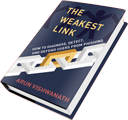Publications
 Vishwanath. A. (2022). The Weakest Link: How to Diagnose, Detect, and Defend Users from Phishing. The MIT Press, Cambridge, MA.
Vishwanath. A. (2022). The Weakest Link: How to Diagnose, Detect, and Defend Users from Phishing. The MIT Press, Cambridge, MA.
Heiding, F., Schneier, B., Vishwanath, A., & Bernstein, J. (2023). Devising and detecting phishing: Large language models vs. smaller human models. arXiv preprint arXiv:2308.12287.
Kwak, Y., Lee, S., Damiano, A., & Vishwanath, A. (2020). Why do users not report spear phishing emails? Telematics and Informatics.
Vishwanath, A. (2020). Stop telling people to take those cyber hygiene multivitamins. In “Prepared for Evolving Threats: The Role of Behavioural Sciences in Law Enforcement and Public Safety” (pp. 225-240), by Majeed Khader (Ministry of Home Affairs, Singapore), Gabriel Ong (Ministry of Home Affairs, Singapore) and Carolyn Misir (Ministry of Home Affairs, Singapore) (Eds).
Vishwanath, A., Neo, L.S., Goh, P., Lee, S., Khader, M., Ong, G., & Chin, J. (2019). Cyber Hygiene: The Concept, its Measure, and its Initial Tests. Decision Support Systems.
Vishwanath, A., Xu, W., & Ngoh, Z. (2018). How People Protect their Privacy on Facebook: A Cost-Benefit View. The Journal of the American Society for Information Science & Technology.
Vishwanath, A. (2017). Getting Phished on Social Media. Decision Support Systems.
Ng, Y.J., Yang, J., & Vishwanath, A. (2017). To fear or not to fear? Applying the social amplification of risk framework on two environmental health risks in Singapore. Journal of Risk Research.
Barnett, G.A., & Vishwanath, A. (2017). Diffusion theories: Logic and the role of media. The International Encyclopedia of Media Effects.
Lee, S., & Vishwanath, A., (2017). Examining Predictors of Self-Care Behaviors in Korean Patientswith Chronic Hepatitis B. Current Psychology.
Vishwanath, A. (2017). Common Method Bias. The International Encyclopedia of Communication Research Methods.
Sirianni, J.M., & Vishwanath, A. (2017). Adopting Computer-based Assessments: The Role of Perceived Value in Classroom Technology Acceptance. Online Journal of Communication and Media Technologies.
Vishwanath, A. (2016). Mobile Device Affordance: Explicating How Smartphones Influence The Outcome Of Phishing Attacks. Computers in Human Behavior, 63, 198-207.
Vishwanath, A. (2016). Spear Phishing: The Tip of the Spear Used by Cyber Terrorists. In M. Khader & L.S. Neo (Eds., Home Team Behavioural Sciences Centre, Ministry of Home Affairs, Singapore) Combating Violent Extremism and Radicalisation in the Digital Era, (pp. 469-484). IGI Global.
Vishwanath, A., Harrison, B., & Ng, Y.J. (2016). Suspicion, Cognition, Automaticity Model (SCAM) of Phishing Susceptibility. Communication Research.
Harrison, B., Svetiva, E., & Vishwanath, A. (2016). Individual processing of phishing emails: How attention and elaboration can protect against individual phishing victimization. Online Information Review, 40(2), 265-281.
Vishwanath, A. (2015). Examining the distinct antecedents of email habits and its influence on the outcomes of a phishing attack. Journal of Computer-Mediated Communication.
Vishwanath, A. (2015). Habitual Facebook Use and its Impact on Getting Deceived on Social Media. Journal of Computer‐Mediated Communication, 20(1), 83-98.
Harrison, B., Vishwanath, A., & Rao, H.R. (2016). A User-Centered Approach to Phishing Susceptibility: The role of a suspicious personality in protecting against phishing. Hawaii International Conference on System Sciences.
Ran, Y., Ng, Y. J, and Vishwanath, A. (2015). Do Social Media Privacy Policies Matter? Evaluating the effects of familiarity and privacy seals on cognitive processing. Hawaii International Conference on System Sciences.
Harrison, B., Vishwanath, A., Ng, Y.J., & Rao, H.R. (2015). Examining the impact of presence on individual phishing victimization. Hawaii International Conference on System Sciences.
Vishwanath, A. (2014). Diffusion of deception in social media: Social contagion effects and its antecedents. Information Systems Frontiers, 1-15.
Vishwanath, A., Herath, T., Chen, R., Wang, J., & Rao, H. R. (2011). Why do people get phished? Testing individual differences in phishing vulnerability within an integrated, information processing model. Decision Support Systems, 51 (3), 576-586.
Vishwanath, A. (2014). The psychology of the diffusion and acceptance of technology. In S. S. Sundar (Eds.) The Handbook of Psychology of Communication Technology,(pp 314-331) Malden, MA: Wiley Blackwell.
Li, J., Vishwanath, A., & Rao, H. R. (2014). Retweeting during the 2011 Japan nuclear radiation incident: An exploration of risk and reassurance communication. Communications of the ACM , 57(1), 78-85.
Vishwanath, A., & LaVail, K.H. (2013). The role of attributional judgments when adopted computing technology fails: A comparison of Microsoft Windows PC user perceptions of Windows and Macs. Behavior and Information Technology, 32 (11), 1155-1167.
Egnoto, M.J., Svetieva, E., Vishwanath, A., & Ortega, C.R. (2013). Diffusion of emergency information during a crisis within a university. Journal of Homeland Security and Emergency Management, 10 (1), 1-21.
Sirianni, J M., & Vishwanath, A. (2017). Problematic online pornography use: A media attendance perspective. The Journal of Sex Research, 53(1), 21-34.
Sirianni, J.M., & Vishwanath, A. (2016). Bad Romance: Exploring the Factors That Influence Revenge Porn Sharing Amongst Romantic Partners. Online Journal of Communication and Media Technologies, 6(4).
Vishwanath, A., (2013). Negative public perceptions of juvenile diabetics: Applying attribution theory to understand the public’s stigmatizing views. Health Communication,1-11.
Kristin, M., & Vishwanath, A. (2020). Discontinuance in Fitness Tracking Apps: An Analysis Using a Diffusion of Innovations Approach. Iowa Journal of Communication, 52, 107-125.
Vishwanath, A., Egnoto, M.J., & Ortega, C.R. (2012). A retrospective analysis of Common Method Variance in communication research. Communication & Science Journal,September 10, 2012.
Sirianni, J.M., & Vishwanath, A. (2012). Sexually explicit user-generated content: Understanding motivations and behaviors using social cognitive theory. Cyberpsychology: Journal of Pyschosocial Research on Cyberspace, 6 (1).
Vishwanath, A. (2011). Global differences in Internet diffusion: An empirical investigation into the effects of culture on the diffusion of the internet. Communication and Science Journal, November 20, 2011.
Vishwanath, A., & Chen, H. (2011). Towards a comprehensive understanding of the innovation-decision process: A relational model of adopter choice. In A. Vishwanath & G.A. Barnett (Eds.) Advances in the Study of the Diffusion of Innovations: A Communication Science Perspective (pp 9-32). New York, NY: Peter Lang.
Vishwanath, A., & Barnett, G.A. (2011). Introduction: The communication science perspective on the diffusion of innovations. In A. Vishwanath & G.A. Barnett (Eds.) Advances in the Study of the Diffusion of Innovations: A Communication Science Perspective (pp 1-8). New York, NY: Peter Lang.
Vishwanath, A., & Chen, H. (2010). Communication technology as an extension of the self in the U.S. and Germany: A cross-cultural study linking people’s associations with technology to their symbolic proximity with others. In M.B. Hinner (Ed.) Freiberger Beitraege zur Interkulturellen und Wirtschaftskommunikation: A Forum for General and Intercultural Business Communication (pp 447-480), Vol. VII, Frankfurt am Main, Germany: Peter Lang GmbH.
Vishwanath, A., Singh, R.S., & Winkelstein, P. (2010). The impact of electronic medical records on outpatient workflows: A longitudinal evaluation of its workflow effects. International Journal of Medical Informatics, 79 (11),778-791.
Vishwanath, A., Brodsky, L., Shaha. S., Leonard, M., and Cimino, M. (2009). Prescriber Attitudes Toward PDA Prescription-Assistance Technology International Journal of Medical Informatics, 78 (5), 330-339.
Vishwanath, A. (2009). From Beliefs to Intentions: The Impact of Framing on the Adoption of Innovations. Communication Monographs, 76 (2), 177-206.
Vishwanath, A., & Chen, H. (2008). Personal Communication Technologies as an Extension of the Self: A Cross Cultural Comparison of People’s Associations with Technology and their Symbolic Proximity with Others. The Journal of the American Society for Information Science & Technology, 59 (11), 1761-1775.
Vishwanath, A. (2009) Using Frames to Influence Consumer Willingness to Pay for the Patient Health Record (PHR): A Randomized Experiment. Health Communication, 24,473-482.
Vishwanath, A., Brodsky, L., & Shaha, S. (2009) Physician Adoption of Personal Digital Assistants (PDA): Testing its Determinants Within a Structural Equation Model. Journal of Health Communication, 14 (1), 77-95.
Vishwanath, A. (2008) The 360 degree News Experience: Audience Connections to the Ubiquitous News Organization. Journalism & Mass Communication Quarterly, 85 (1), 7-22.
Vishwanath, A. (2007) Information Search Efficacy: A new measure and its initial tests. Communication Research Reports, 24 (3), 195-203.
Vishwanath, A. & Scamurra, S. (2007) Barriers to the Adoption of Electronic Health Records: Using Concept Mapping to Develop a Comprehensive Empirical Model. Health Informatics Journal, 13, 119-134.
Vishwanath, A. (2006) Effect of the number of opinion seekers and leaders on technology adoption. Human Communication Research, 32 (3), 322-345.
Vishwanath, A. & Chen, H. (2006). Technology clusters: Using multidimensional scaling to evaluate and structure technology clusters. The Journal of the American Society for Information Science & Technology, 57 (11), 1451-1460.
Vishwanath, A. (2005). Impact of personality on technology adoption: An empirical model. The Journal of the American Society for Information Science & Technology,56 (8), 803-811.
Vishwanath, A. & Barnett, G.A. (2005). An Empirical Investigation into the structure of bidding in online auctions. Electronic Markets. 15 (3), 261-268.
Vishwanath, A. (2004). An empirical investigation in to the use of heuristics and information cues by bidders in online auctions. Electronic Markets: Special Issue on Online Auctions, 14 (3), 178-185.
Vishwanath, A. (2004). Manifestations of interpersonal trust in online interaction: A cross-cultural study comparing the differential utilization of seller ratings by eBay participants in Canada, France, and Germany. New Media & Society, 6 (2), 85-101.
Vishwanath, A. (2003). Comparing online information effects: A cross-cultural comparison of online information and uncertainty avoidance. Communication Research, 30 (6), 579-598.
Vishwanath, A., & Goldhaber, G.M. (2003). An examination of the factors contributing to adoption decisions among late diffused technology products. New Media & Society, 5(4), 547-572.
Vishwanath, A., & Barnett, G .A. (in-press). Asynchronous bidding behavior in online auctions. In D. Krikorian (Ed.), Progress in Communication Sciences: Internet Research, Ablex: Greenwich, CT.
Vishwanath, A., & Barnett, G.A. (2011). Advances in the Study of the Diffusion of Innovations: A Communication Science Perspective, New York, NY: Peter Lang.
